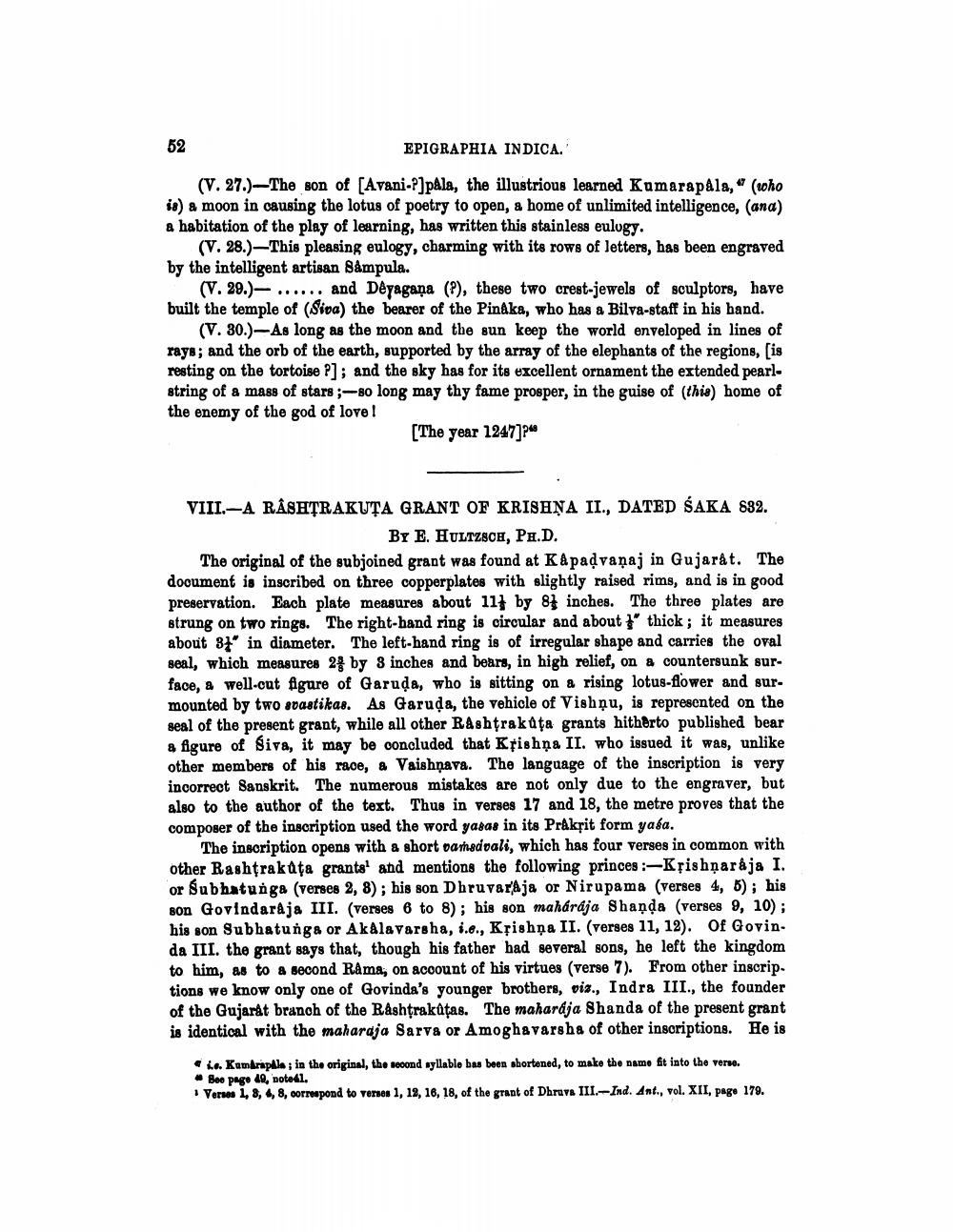________________
EPIGRAPHIA INDICA.
(V. 27.)-The son of [Avani-P]pAla, the illustrious learned Kumarapala, who is) a moon in causing the lotus of poetry to open, a home of unlimited intelligence, (ana) a habitation of the play of learning, has written this stainless eulogy.
(V. 28.)- This pleasing eulogy, charming with its rows of letters, has been engraved by the intelligent artisan Sampula.
(V. 29.) ...... and Deyagana (R), these two crest-jewels of sculptors, have built the temple of (Siva) the bearer of the Pinkka, who has a Bilva-staff in his hand.
(V. 30.)- As long as the moon and the sun keep the world enveloped in lines of rays; and the orb of the earth, supported by the array of the elephants of the regions, [is resting on the tortoise ?]; and the sky has for its excellent ornament the extended pearlstring of a mass of stars ;-80 long may thy fame prosper, in the guise of (this) home of the enemy of the god of love!
[The year 1247]?*
VIII.-A RASHTRAKUTA GRANT OF KRISHŅA II., DATED SAKA 882.
BY E. HULTZSCH, PH.D. The original of the subjoined grant was found at Kapadvanaj in Gujarat. The document is inscribed on three copperplates with slightly raised rims, and is in good preservation. Each plate measures about 11: by 8} inches. The three plates are strung on two rings. The right-hand ring is circular and about thick; it measures about 87" in diameter. The left-hand ring is of irregular shape and carries the oval seal, which measures 24 by 3 inches and bears, in high relief, on a countersunk surface, a well-out figure of Garuda, who is sitting on a rising lotus flower and surmounted by two svastikas. As Garuda, the vehicle of Vishņu, is represented on the seal of the present grant, while all other Rashtrakața grants hitherto published bear a figure of Siva, it may be concluded that Ktishņa II. who issued it was, unlike other members of his race, & Vaishnava. The language of the inscription is very incorrect Sanskrit. The numerous mistakes are not only due to the engraver, but also to the author of the text. Thus in verses 17 and 18, the metre proves that the composer of the inscription used the word yasas in its Prakrit form yaba.
The inscription opens with a short paneddali, which has four verses in common with other Rashtrakața grants and mentions the following princes :-Kfishnaraja I. or Subhatunga (verses 2, 8); his son Dhruvar'dja or Nirupama (verses 4, 6); his Bon Govindaraja III. (verses 6 to 8); his son maharaja Shanda (verses 9, 10); his son Subhatunga or Akalavarsha, i.e., Kțishņa II. (verses 11, 12). Of Govin. da III. the grant says that, though his father had several sons, he left the kingdom to him, as to a second Rama, on acoount of his virtues (verse 7). From other inscriptions we know only one of Govinda's younger brothers, vis., Indra III., the founder of the Gujarat branch of the Rashtrakațas. The maharaja Shanda of the present grant is identical with the maharaja Sarva or Amoghavarsha of other inscriptions. He is
L. Kamaraphila; in the original, the second syllable bas been shortened, to make the name fit into the venue. • Bee Page 40, note41.
Verse 1, 3, 4, 8, correspond to verson 1, 12, 16, 18, of the grant of Dhruva III.-Ind. Ant., vol. XII, pago 179.




